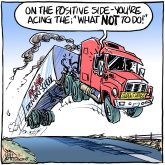Horses’ curious, playful nature and quick instinctive reactions work best in open spaces.
When frightened, they flee as nature intended them to do, often blindly running into wire fences, steel panels and grounded obstacles.
Unfortunately, horse skin is unforgiving to such insults. It is thin and delicate, unlike the thick hide of a cow.
The types and location of wounds will vary immensely, but the picture of healing is common to all wounds.
Every horse comes with a doctor inside it. There is an inherent process of wound healing that is highly intelligent and purposeful. As caregivers, we support that capacity for healing.
Read Also

Rural communities can be a fishbowl for politicians, reporter
Western Producer reporter draws comparisons between urban and rural journalism and governance
The process continually brings changes in the tissue. Three distinct phases occur during healing.
The body assesses the damage and cleans it up. Depending on the severity of the injury and bruising, this phase can last seven to 10 days.
Often during this phase the wound does not look like it is thriving. That’s because it isn’t. The tissue is deciding whether it will live or die.
Although some cuts are simply incisions of the skin layer, most are associated with struggling and trauma that cause bruising to the surrounding tissue. This can involve blood supply, muscle, ligaments, tendons, connective tissue and bone.
Swelling, discharge and discolouration during this phase are part of the healing process. Swelling is the body’s way of taking care of this new crisis. It brings increased circulation and cellular components that will attend the wound.
Hydrotherapy is valuable, removing the damaged tissue that could serve as a medium for bacteria. This phase can be disturbing because tissue separated from a viable blood supply dies and sloughs away. Antibiotics may be needed.
Granulation is bright red, bubbly tissue that begins to fill in the wound. It is highly vascular, bringing in the cellular component responsible for tissue growth.
It is the connective tissue framework, like scaffolding, with its supporting blood supply. As building occurs, so does rebuilding. Scaffolding is put up and taken down.
This phase is resistant to infection because of its huge blood supply.
Most salves, creams and sprays at this stage have been found to deter cell growth and inhibit tissue growth. Shark oil is the only product shown to enhance this phase of healing. The most readily accessible source of shark oil is Preparation H.
Scabs are Mother Nature’s bandages. They are simple coverings that protect the healing wound and keep it moist, clean and warm, providing the ideal environment. Bandages may be used when they can improve the environment for healing by supplying the basic elements that a scab would offer. Ill-fitting bandages may inhibit the blood circulation necessary for healing.
Wound edges will usually contract together and orient tissue fibres to match the horse’s movement. This phase can be long term, with scars and wound edges remodelling for months or years.
The most effective care is often simple and timely.
Taking care of the horse with appropriate nutrition, exercise, environment and companionship is of utmost importance because it helps the horse better care for its own wound.
Carol Shwetz is a veterinarian practising in Westlock, Alta.














